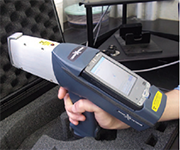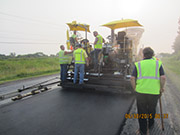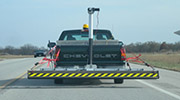|
Page Content SHRP2 Nondestructive Testing Solutions | |

|
FHWA’s Nondestructive Evaluation (NDE) Web Manual allows users to search for technologies relevant to specific materials, types of deterioration, and/or infrastructure elements. It includes also best practices, sample applications, and performance attributes of various technologies. | |
- Geophysical, mobile-scanning, and hand-held technologies to help inspect
concrete bridge decks or tunnel linings more quickly and comprehensively.
- Tools to detect project-level pavement
delamination and debonding early on in a project.
- Infrared and radar technologies that provide
real-time testing of nearly 100 percent of the pavement area during construction.
- Market-ready technologies that provide
real-time verification to ensure construction materials meet specifications.
- Proven technologies to help improve concrete
pavement smoothness during construction.
- Advanced utility identification technologies to detect, locate, and characterize subsurface utilities.
| |
|
| |
|
Technologies that define the actual extent of deterioration—beyond what can be seen—for improved repairs. - Geophysical technologies for evaluating and inspecting concrete bridge decks; mobile-scanning and hand-held technologies for mapping voids, debonding, delaminations, moisture, and other defects behind or within tunnel linings.
- For more information, visit the
R06 A/G product page.
- Implementation states for R06A: Alabama, Arkansas, California, Delaware, Florida, Georgia, Hawaii, Indiana, Iowa, Kentucky, Louisiana, Missouri, Nebraska, New Mexico, New York, North Carolina, North Dakota, Oregon, Pennsylvania, and Virginia; implementation states for R06G: California, Colorado, Oregon, Pennsylvania, and Virginia.
- Contact: Hoda Azari, FHWA, Hoda.Azari@dot.gov.
|
| |
|
Two market-ready technologies were introduced, X-ray Fluorescent Spectroscopy (XRF) and Fourier-Transform Infrared Spectroscopy (FTIR), that can be used during construction to verify the chemical compounds or presence of certain additives or contaminants in some commonly used construction materials. |
|

X-Ray Florescence (XRF) | |
Two products were used to provide real-time testing of potentially 100 percent of the pavement area, providing much more inspection coverage than existing methods for Asphalt Pavement construction. - For more information, visit the
R06C product page.
- States that implemented R06C (IR): Alabama, Alaska, Illinois, Maine, Missouri, New Jersey, North Carolina, Virginia, and West Virginia; R06C (GPR): Nebraska, Maine.
- Contact: Steve Cooper, FHWA, Stephen.j.cooper@dot.gov.
|
|

Using IR scanner for pavement project, Peoria, IL | |
|
|
Three technologies – GPR and IE technology, combined with the Seismic Analysis of Surface Waves (SASW) system – to detect project-level pavement delamination and debonding before the deficiencies cause visual pavement distress. |
|

Ground Penetrating Radar Antenna Array | |
|
Information and tools to evaluate pavement smoothness in real-time while the concrete is still wet. - Through equipment loans and demonstrations, states participating in the Implementation Assistance Program (IAP), along with a number of non-IAP participating states, received hands-on experience using these tools, along with training.
- For more information, view the
R06E fact sheet.
- States that implemented R06E: Alabama, Idaho, Indiana, Ohio, and Pennsylvania. Technical assistance is available to support additional agencies if requested.
- Contact: Steve Cooper, FHWA, Stephen.j.cooper@dot.gov.
|
| | |
|
Two advanced utility identification technologies were introduced that may help transportation agencies looking for more detailed information than previously known about their subsurface utilities. The first is Multi-Channel Ground Penetrating Radar (MCGPR). Since this technology does not work well in clay soils, a second technology was identified in the research. Time Domain Electromagnetic Induction (TDEMI) can work in highly conductive soils; however, it cannot detect non-metallic utilities without a tracer wire. Soil type, terrain, and other geophysical attributes will help determine which technologies are appropriate for a given location. |
| |
|
|
